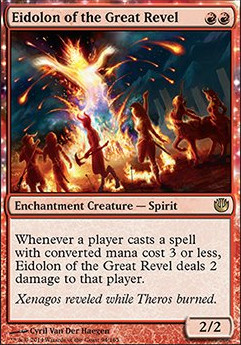Modern Burn
"The thing about Burn is that it falls into the category of deck that is really easy to play at 85% efficiency... but squeaking out those last 15% is something only seasoned Burn veterans can do." - Gavin Verhey, Magic R&D.
If you only remember one thing from this description, remember this: Burn is basically a combo deck. Your combo is 6-7 burn spells. You must use your spells in a way that will allow you to actually win the game. Play this like you would play Storm. When you build your own burn deck, look at every card and ask yourself if this card contributes to the plan. If it does not, do not play it. You need every spell in your deck to guarantee damage. Again, if it does not, do not play it. Your greatest strength is consistency. Spells that can't consistently deal damage are not playable.
What I'm trying to offer with this guide is not merely a decklist, but also a guide on how Burn should be built and played. Contrary to popular belief, Burn requires thought in both deck construction and play. You don't really get to make mistakes, because every other deck plays more powerful cards than you. However, we've pushed our way up to a 9% meta share by being as redundant and uninteractive as possible. These are the things that make Burn actually good.
These are the questions that you should be able to answer, preferably with yes:
1) Are all my spells similar enough that I don't need any specific card to win?
2) Are all my spells good against commonly played interaction? (This means creature removal)
3) Do I have the tools necessary to beat other forms of interaction? (This means discard, countermagic, lifegain, and creatures)
Maindeck
Building your starting 60 is pretty easy. You just want to be playing the best burn spells. It's pretty easy to just rank all of them in order.
- Lightning Bolt
- Lava Spike
-
Bump in the Night
-
Rift Bolt
-
Searing Blaze
- Atarka's Command
- Skullcrack
- Boros Charm
- Shard Volley*
Same goes for the creatures.
- Goblin Guide
- Monastery Swiftspear
- Eidolon of the Great Revel
- Grim Lavamancer*
* Don't play 4 of these
Basic tips for playing well
Mulligans
I'll defer to Patrick Sullivan on this one.
"The thresholds for mulligans are:
1) One-landers with numerous 2+ mana spells, or one-landers with 2x Fireblast that lack significant upside (like 2x Searing effects vs. Death and Taxes)
2) 4 land hands without a creature and without multiple high-upside spells (Prices or Searing effects in their best matchups).
3) 4 land hands that can't kill a creature in a matchup where that matters (Stoneforge Mystic, Elves, etc.)
4) 5+ land hands regardless of composition (barring extreme outliers like 2x Grim Lavamancer 5x Fetch Land on the play vs. Elves)."
Obviously, this was written about Legacy, but much of it holds true for Modern. Pretty much all 2 and 3 land hands are keepable. One thing I would amend is that in Modern, 4 land hands are never keepable. You don't have Price of Progress to bail you out.
Sideboard Guide and Philosophy
"Trading one-for-one when your deck is full of Lava Spikes is a recipe to lose the game with your opponent at seven life. As such, I have no interest in Red Elemental Blasts, Shattering Sprees, or other similar cards I see scattered in other people's sideboards. The only things I want are things that deal damage, or cards that lock my opponent out of the game entirely." - Patrick Sullivan
A lot of what I would say here is repeated from the last section. Essentially, you want cards that will either deal damage or win the game. It should be relatively obvious what cards should be switched up in every matchup, so I won't offer a complete guide.
Matchups
Favorable:
BG/x Midrange (all variants) - "Burn attacks in a manner that Jund can't hope to compete with" - Michael Jacob
- Slow clock
- Takes damage from lands
- Has very few ways to interact
This rings very true for all BG Midrange variants. Their decks are so full of blanks against you that all but their best draws can't beat your average draws. Try to empty your hand as fast as possible to play around their discard, but hold up Skullcrack if possible. If you have an opportunity to trade a creature and a
Searing Blaze
for a Tarmogoyf, always do so. They need that to beat you.
Grixis (all variants)
- Takes damage from lands
- Has very few ways to interact
While they all have the same shell, it's important to understand the differences between Grixis Delver, Twin, and Control. While they can all default to looping Snapcaster Mage and Kolaghan's Command, that strategy isn't good against you. Delver will attempt to get off the ground early with cheap threats, but their deck runs few of them and they get wrecked by
Searing Blaze
. Twin needs to find the combo before they get overwhelmed. Control needs a fast delve creature, and even that won't kill you until turn 5-6. Most importantly, these colors have extremely few good sideboard cards against you. The tools just don't exist in these colors.
RG Tron
- Slow clock
- Has very few ways to interact
You're probably noticing a theme here: Tron will often just lie back and let you kill them, which is exactly what you want. You are also entirely capable of beating any of their plays off turn 3 Tron: Your hand empties fast enough that
Karn Liberated
won't do too much, and 8 Skullcrack effects can keep you up for a few turns after Wurmcoil Engine.
Resources

